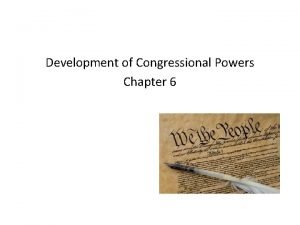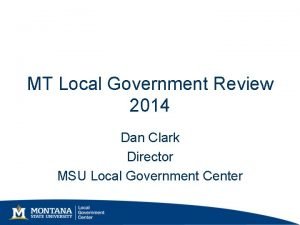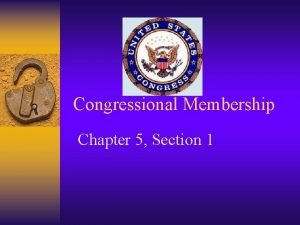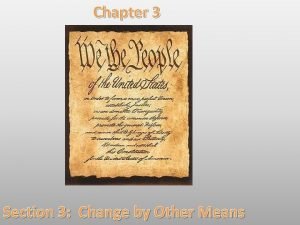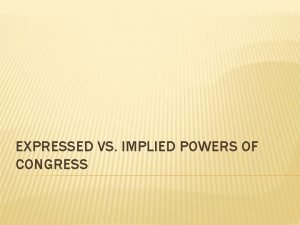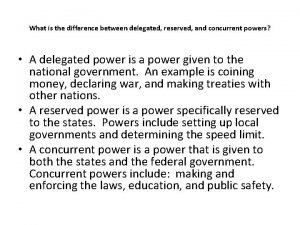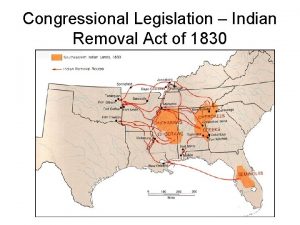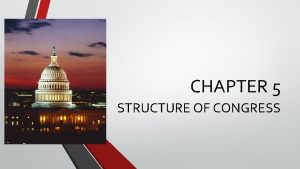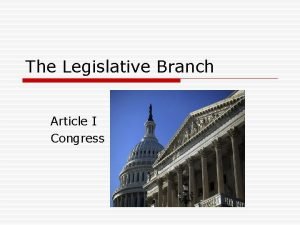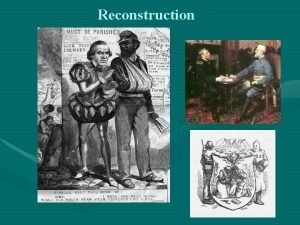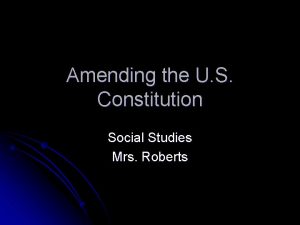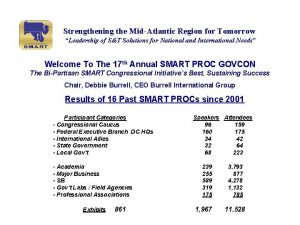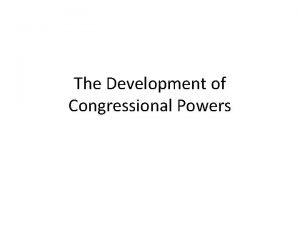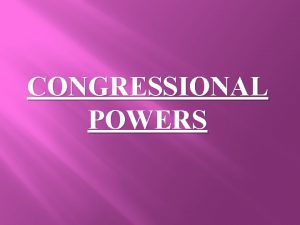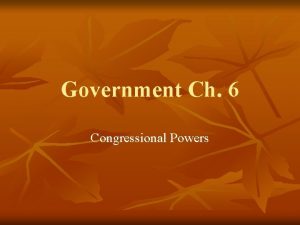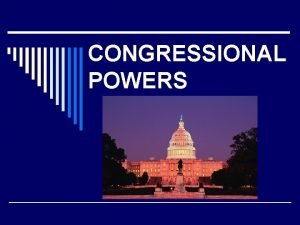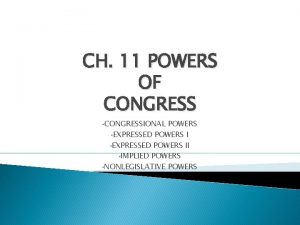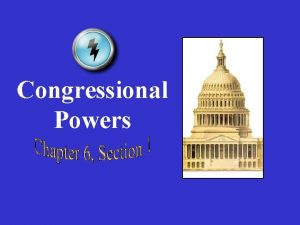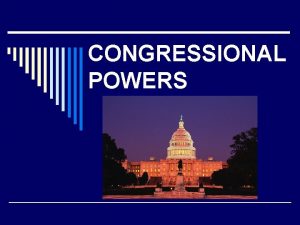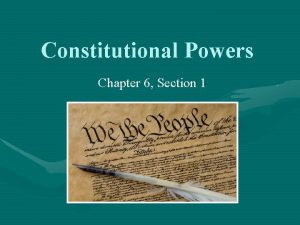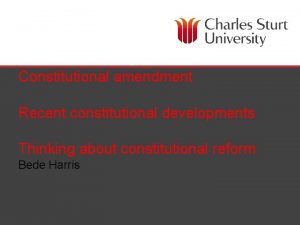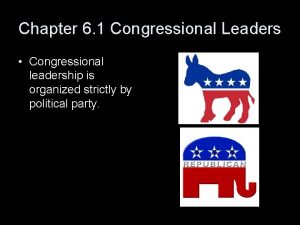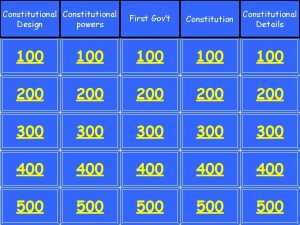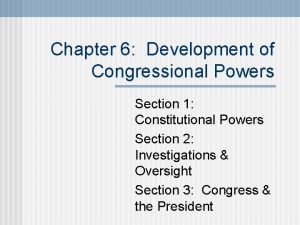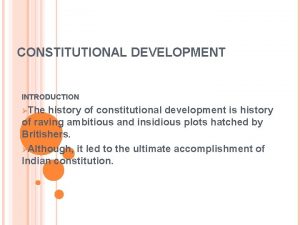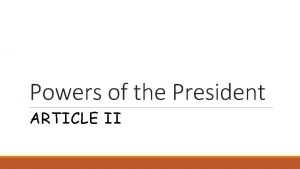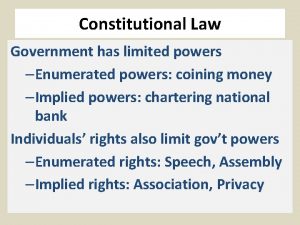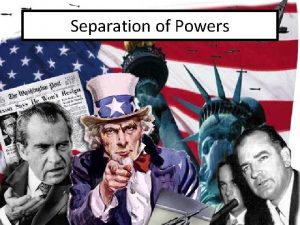Development of Congressional Powers Chapter 6 Constitutional Powers






















- Slides: 22

Development of Congressional Powers Chapter 6

Constitutional Powers Sec. 1

Constitutional Provisions (pages 157– 158) A. The “necessary and proper” clause (elastic clause) of the Constitution enables Congress to expand its power. B. Conflicting interpretations of the elastic clause are reflected in Supreme Court rulings on the power of Congress. (Strict/loose) C. The powers of Congress are limited by the Bill of Rights and the Constitution.

Article 1, Section 8 • Expressed powers – listed in the constitution • Implied powers – a way to full fill the Expressed powers ( elastic Clause)

Powers Denied Congress • Limited by the Bill of Rights • Congress cannot suspend the writ of habeas corpus • Congress cannot pass bills of attainder, laws that establish guilt and punish people without allowing them a trial. • Congress is prohibited from passing ex post facto laws

Legislative Powers (pages 158– 163) A. The power to levy taxes and appropriate money is one of Congress’s most important powers. B. Congress has the power to borrow money, to coin money, and to make laws regarding bankruptcy. ***Revenue bills always originate in the House of representatives.

C. Congress has the power to regulate foreign and interstate commerce. (Gibbons v Ogden) D. Congress has important powers in foreign policy and national defense, such as the power to approve treaties, to declare war, and to create and maintain an army and a navy. ***Appropriations bills – proposed laws to authorize spending money

E. Congress has power over naturalization of citizens and the admission of new states to the Union. F. Congress has the power to grant copyrights and patents and the power to establish federal courts and a post office.

Nonlegislative Powers (pages 163– 165) A. If no presidential candidate has a majority of the electoral votes, the House of Representatives chooses the president from the top three candidates; if no vice presidential candidate has an electoral vote majority, the Senate chooses the vice president from the top two candidates. B. Congress has the power to settle problems arising from the death of candidates or the president’s incapacity or resignation. (20 th and 25 Amendment)

C. Congress has the power to remove officials of the executive or judicial branches from office by the process of impeachment. D. The Senate has the power to approve officials appointed by the president. E. The Senate ratifies treaties between the United States and other nations.

F. Congress shares with state legislatures the power to propose and ratify constitutional amendments.

Congress at Work Chapter 7

How a Bill Becomes a Law sec. 1

Types of Bills and Resolutions (pages 181– 183) A. Public bills involve national issues; private bills deal with individual people or places. B. Resolutions may be passed by either house or by both houses jointly. C. Both houses pass concurrent resolutions, which do not have the force of law. D. A rider is a provision attached to a bill on an unrelated subject.

E. Only a few bills become laws because: 1. the process is long and complex 2. measures must have broad support 3. supporters must be willing to compromise 4. many bills are introduced that have no chance of passing.

Introducing a Bill (pages 183– 186) A. Introducing a new bill in Congress is the first step in the lawmaking process. B. New bills are sent to committees and sometimes subcommittees. C. Both houses usually agree with the committees’ decision on a bill.

D. If a committee decides to act on a bill, it holds hearings on it. E. When a committee hearing is complete, committee members review the bill line by line and make changes in it by a majority vote. F. The committee kills or reports the bill to the House or Senate, sending with the bill a written report that describes the bill, explains the committee’s actions, lists the committee’s changes, and recommends passage or defeat.

Floor Action (pages 186– 187) A. During debate any lawmaker may offer amendments. B. The bill, including proposed changes, must receive a majority vote in both the House and Senate to pass. C. Congress may use standing, roll-call, record, or voice votes.

Final Steps in Passing Bills (pages 187– 188) A. To become a law, a bill must pass in identical form in both houses; conference committees work out differences when necessary, and send a compromise bill to each house of Congress for final action. B. The president may then let the bill become law by signing it or keeping it 10 days without signing it, or kill it using a veto or pocket veto.

C. Congress can override a presidential veto by a two-thirds vote in each house. D. Pocket Veto - the president refuses to act on a bill passed during the last 10 days of the session. By failing to act kills the bill E. After a bill becomes a law, it is registered with the National Archives and Records Service. F. Citizens can track legislation using an online information resource called THOMAS.

The Influence of Interest Groups Lobbyists – representatives of interest groups that influence Congress in their favor (lobbying)

Chapter 6 & 7 assignment Complete questions handout Play bingo Extra Credit – Chapter 5 pg. 167, # 1 – 6, Chapter 6, pg. 195 # 1 – 3, Chapter 7, pg. 227, pg. 1 & 2
 Development of congressional powers chapter 6 answer key
Development of congressional powers chapter 6 answer key Development of congressional powers chapter 6 answer key
Development of congressional powers chapter 6 answer key Implied powers of congress
Implied powers of congress Constitutional powers
Constitutional powers Constitutional development in pakistan from 1947 to 1973
Constitutional development in pakistan from 1947 to 1973 Chapter 5 lesson 1 congressional membership
Chapter 5 lesson 1 congressional membership The structure of congress lesson 1 congressional membership
The structure of congress lesson 1 congressional membership Chapter 3 section 3 constitutional change by other means
Chapter 3 section 3 constitutional change by other means Was the united states on the axis powers or allied powers?
Was the united states on the axis powers or allied powers? What were the 4 main causes of wwi
What were the 4 main causes of wwi Expressed powers and implied powers
Expressed powers and implied powers What's the difference between enumerated and implied powers
What's the difference between enumerated and implied powers Enumerated vs expressed powers
Enumerated vs expressed powers Concurrent reserved and delegated powers
Concurrent reserved and delegated powers Presidential powers informal or implied powers
Presidential powers informal or implied powers Truman vs eisenhower venn diagram
Truman vs eisenhower venn diagram Congressional act of 1830
Congressional act of 1830 Lesson 1 congressional membership
Lesson 1 congressional membership Arizona congressional districts
Arizona congressional districts The term reconstruction refers to
The term reconstruction refers to Restraint on congressional salaries amendment
Restraint on congressional salaries amendment Smart congressional initiative
Smart congressional initiative Presidential and congressional reconstruction venn diagram
Presidential and congressional reconstruction venn diagram
